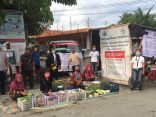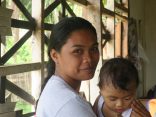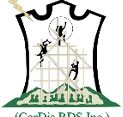(This feature story was also published online by GMA News Online, Philstar.com, and PTV4.)
By Darwin Masacupan
In photo: Barangay Batuan’s roving team, composed of Nick Basong, Katherine Boga, and Edwin dela Cruz, gamely smiles for the camera
Familiarity with the people and the area. Willingness to pitch in and do their part. Commitment to finish the job… and do it well. These are what community roving teams, working with ACCORD and CARE, bring to shelter recovery efforts in Haiyan-affected areas. These qualities are all exemplified by the roving team of Barangay Batuan in San Dionisio, Iloilo.
Disaster risk reduction (DRR) is ACCORD’s primary consideration in its programming. To help ensure that disaster risk reduction techniques are incorporated in all house repairs and/or reconstruction, roving team, composed of two skilled carpenters and a female community facilitator (CF) were formed in each covered barangay.
(This feature story was also published online by GMA News Online, Philstar.com, and PTV4.)
By Darwin Masacupan
In photo: Barangay Batuan’s roving team, composed of Nick Basong, Katherine Boga, and Edwin dela Cruz, gamely smiles for the camera
Familiarity with the people and the area. Willingness to pitch in and do their part. Commitment to finish the job… and do it well. These are what community roving teams, working with ACCORD and CARE, bring to shelter recovery efforts in Haiyan-affected areas. These qualities are all exemplified by the roving team of Barangay Batuan in San Dionisio, Iloilo.
Disaster risk reduction (DRR) is ACCORD’s primary consideration in its programming. To help ensure that disaster risk reduction techniques are incorporated in all house repairs and/or reconstruction, roving team, composed of two skilled carpenters and a female community facilitator (CF) were formed in each covered barangay.
Context
Batuan is heavily reliant on agriculture, but only a few families own majority of the land. They are dependent on rains given that there are no irrigation facilities in the area. Incomes are low and they have to resort to borrowing just to get by day-to-day. Savings are basically unheard of.
Haiyan worsened an already bad situation. Edwin dela Cruz and Nick Basong, carpenters for Batuan’s roving team, shared that Haiyan heavily damaged their houses. For her part, Kathy Boga, barangay health worker and CF, says that she went back to their province just before Yolanda. “My son had epilepsy. Since I could not afford hospital treatment in Manila, I thought the clean air here would help, and it did. What I did not count on was how strong typhoons here could be.”
Only 8 of 167 houses in their barangay remained standing, and sources of food like fish and poultry were gone. The severity of Haiyan’s effects was a deciding factor for ACCORD and CARE, supported by the European Commission’s Humanitarian Aid and Civil Protection department (ECHO) and the Dutch Cooperating Aid Agencies (SHO), to work with their community in building back their lives.
“We were happy when they came in. They did not just distribute shelter repair kits, they also conducted trainings on Build Back Safer (BBS) techniques for all our carpenters,” says Kathy.
Bayanihan
The indigenous practice of bayanihan (mutual aid) is alive in communities like Batuan. Groups of up to 10 members were mobilized to help each other out in rebuilding houses, prioritizing those of the most vulnerable like the elderly and persons with disabilities. Bayanihan is also the driving spirit behind roving teams.
Edwin and Nick were selected for the roving team, even if they were not beneficiaries, because of their skills as well as to help them recover from the effects of the super typhoon. Katherine was picked because she knew everyone in the barangay. She also had to learn and know BBS by heart so that she could lead and motivate her neighbors to build back better.
“Every Friday, we go around our barangay to check the quality of materials used by our neighbors, the progress of repairs, and compliance with the BBS tips taught in trainings,” says Edwin. “The most important thing is to strengthen the roof, so that they don’t easily get blown away, and thus families could have protection from the elements. We also check if they use strong bracing, so that houses would not be easily pushed over or pulled apart by the wind,” adds Nick. Tying down every part from bottom up, strengthening foundations, and the use of sturdy joints also contribute to making houses more durable.
Commitment
Being part of the roving team was not easy. “We also had other jobs to help provide for our families. We had to juggle our schedules well,” shares Edwin. Kathy chimes in, “We also have to be patient when some of our neighbors tell us that we should just leave them alone. We explain that we are all in this together, and we have to look out for each other.”
Another challenge was the fact that people just don’t earn enough to buy additional materials. “We make do and adjust. We get creative with the materials we use. We adjust on the number of nails but we never sacrifice the integrity of the structures,” says Nick. Even non-beneficiaries in their barangay have adopted the model of houses they monitored, confident that these would withstand future storms better.
Today, all 92 beneficiary houses in Batuan have been completed, although some continue to use tarpaulins and temporary materials for their ceilings. The roving team has now received a small honorarium, but they all agree that money was never on their mind when they decided to help.
“We are part of this barangay, and we wanted to finish rebuilding as soon as possible,” Edwin shares. They are confident of the houses they monitored. Nick says that, “We can never be 100% sure, given that typhoons are becoming stronger, but unlike before they won't be blown away as easily.”
Growth
All three are now excited for the livelihood and DRR capacity building activities that will start soon in their barangay. Kathy is now part of the committee that will select beneficiaries based on their income and need. But they will not forget what they have learned from their time as members of the roving team.
“It is better to be prepared for anything. When Haiyan came, we thought it was going to be like previous typhoons we experienced. We now know better. Whether it’s rebuilding houses or livelihoods, one thing is clear: we can’t leave things to chance,” says Kathy.




